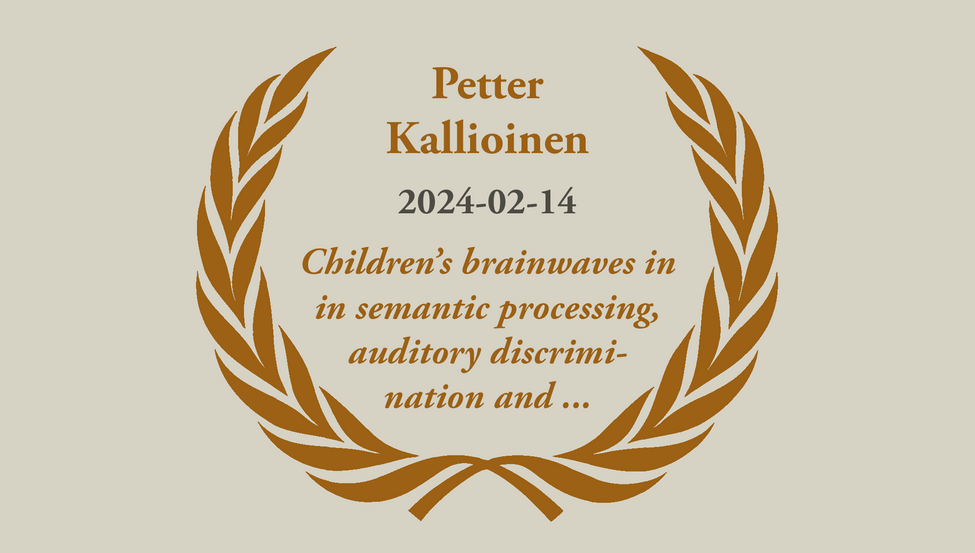At February 14:th, 2021, Petter Kallioinen successfully defended his PhD thesis: Children’s brainwaves in semantic processing, auditory discrimination and selective attention – in deaf and hard-of-hearing and typically hearing populations
Opponent: Professor Dr. Claudia Männel, Max Planck Institute for Human Cognitive and Brain Sciences, Leipzig.
Abstract. In the present thesis, brainwaves analyzed as event-related potentials (ERPs), have been measured in children who are Deaf and Hard-of-Hearing (DHH) and in children with Typical Hearing (TH), in two different intervention projects. One investigated a computer-assisted reading intervention with a phonics approach for children with hearing loss, and one evaluated two different teaching methods in Swedish preschools. In study I and II participants were 5–7 years-old children with cochlear implants (CI. N=15), conventional hearing aids (HA. N=15) or typical hearing (TH. N=12). In study I the N400 component, reflecting semantic processing, was investigated and in study II auditory mismatch responses (MMR) were measured in a paradigm with contrasts in five auditory dimensions (duration, intensity, pitch, location and gap insertion). The purpose of study I and study II was to study group differences in processing, and to evaluate effects of a computer- assisted reading intervention with a phonics approach. In study I, a larger N400 effect was found in children with CI, compared to children with HA and TH. Since children with CI in this study had lower semantic skills compared to children with TH, and because ERPs differed at early latencies and as a function of semantic relatedness, this result was interpreted as a reflection of increased semantic top- down processing in children with CI. In study II we found a mismatch negativity (MMN) effect for the duration deviant, while other sound contrasts resulted in positive mismatch responses (pMMR), not typical for the present age group but often found in much younger children. Study III is a review of four existing N400- studies of semantic processing in children with CI. Participants with CI (N=88) in the included studies were 1–10 years-of-age. We found N400 effects in all participant groups except in very young children with additional impairments. A replication of the large N400 effect of study I, including the early latency effect is discussed and give suggestions for future research including studying children with HA, and understudied group. In study IV and V, we investigate 4–6-year-old children in preschools (N=431). The children participated in extensive behavioral testing, and a subgroup of 138 children tested auditory selective attention as differences in ERP responses to probe sounds embedded in attended and unattended stories. The goal of study IV was to evaluate cognitive effects of preschool teaching practices in a randomized control trial (RCT) intervention study and investigate effects of background variables such as socioeconomic status (SES). In study V we investigate relations between executive functions (EF), selective auditory attention and several measures of language skills in data from the same project. The preschool interventions of study IV did not result in better EF, language, communication or early math skills, compared to controls. SES did predict EF and early math. Selective auditory attention had an expected effect with positive polarity at early latencies and an unexpected effect with negative polarity in later latencies. In study V we found that vocabulary measures had the highest correlations with EF, suggesting that studies that only use vocabulary might overestimate the relationship between EF and language. The selective auditory attention measure did not correlate with any EF measures, but did have weak correlations with language tests. Results in study I and III suggest that semantic top-down processing can be enhanced to compensate for difficulties in language comprehension in children with CI. However, the compensatory top-down processing is limited by difficulty of the language material, noise, and in being effortful. Studies of auditory responses (study II, IV and V) include results that are not typical for the studied age groups. Atypical age effects could be related to task difficulty. The effect of SES on cognitive measures suggest that the compensatory mission of Swedish preschool policy is important, as cognitive differences are found already at this age. Results overall suggest continuous interaction between cognitive faculties that can sometimes take compensatory roles.

